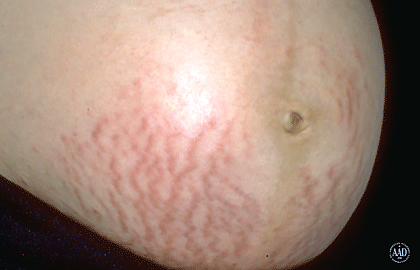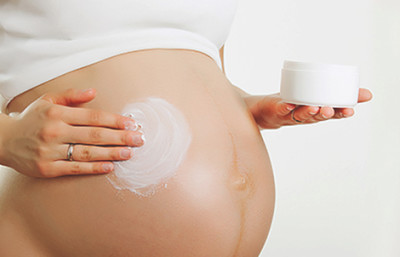Stretch marks: Why they appear and how to get rid of them
What exactly is a stretch mark?

Not everyone develops these narrow bands on their skin. Fluctuating hormone levels seem to play a role. You may also have a higher risk if people in your family get stretch marks.
If you develop stretch marks, you’re most likely to do so during these times:
Growth spurts that happen in puberty
Pregnancy
Rapid weight loss or gain
Weight training when you have rapid muscle growth
Applying a corticosteroid to your skin for a long time can also cause stretch marks. If you have Cushing’s disease or Marfan syndrome, you may see stretch marks.
When stretch marks first appear, they tend to be red, purple, pink, reddish-brown, or dark brown, depending on your skin color. Early stretch marks may feel slightly raised and can be itchy.
In time, the color fades and the narrow bands sink beneath your skin. If you run your finger over a mature stretch mark, you often feel a slight depression.
What can get rid of stretch marks?
Like any scar, stretch marks are permanent, but treatment may make them less noticeable. Treatment can also help alleviate the itch.
If you’re pregnant or breastfeeding, check with your doctor before treating stretch marks. Some products contain ingredients, such as retinol, that can harm your baby.

It’s important to understand that no single treatment works for everyone — and many products don’t seem to work at all. Here’s what researchers have discovered about the many treatments for stretch marks.
Stretch mark creams, lotions, and gels: Researchers have studied many of the creams, lotions, and gels sold to treat stretch marks. While no one product seems to help all of the time — and some don’t seem to help at all — researchers have discovered some helpful hacks.
If you want to try one of these creams, lotions, or gels to fade stretch marks, be sure to:
Use the product on early stretch marks. Treatment seems to have little effect on mature stretch marks.
Massage the product into your stretch marks.Taking time to massage the product gently into your skin may make it more effective.
Apply the product every day for weeks.If you see results, they take weeks to appear.
Home remedies: In studies, popular home remedies have not worked. Researchers found that none of the stretch marks faded when people massaged almond oil, cocoa butter, olive oil, or vitamin E into their stretch marks.
Tanning cannot get rid of stretch marks. When you tan, stretch marks become more noticeable because they don’t tan.

Self-tanner: While tanning can make stretch marks more noticeable, a self-tanner can camouflage stretch marks — both early and mature ones. A self-tanner cannot get of rid of stretch marks.
Prescription medicine you apply to your skin: In studies, two ingredients seem to offer some relief:
Hyaluronic acid
Tretinoin
In two large studies, applying hyaluronic acid to early stretch marks made the stretch marks less noticeable.
Tretinoin is a retinoid, which may also make early stretch marks less noticeable. In one study, people who applied this prescription cream every night for 24 weeks had less noticeable stretch marks. Those who didn’t apply the cream saw their early stretch marks grow. Other studies have found similar results.
Retinol, another type of retinoid, may also help fade early stretch marks.
Procedures that dermatologists perform: Dermatologists use the following procedures to make stretch marks less noticeable, but none of these can get rid of stretch marks:
Chemical peel
Laser therapy
Microdermabrasion
Radiofrequency
Ultrasound
To give you the best results, your dermatologist may use more than one procedure. For example, your dermatologist may treat you with radiofrequency and a pulse dye laser.
With all procedures, side effects are possible. In the skilled hands of a board-certified dermatologist, side effects tend to be minor and temporary. It’s common to have some redness and swelling after a procedure. The redness and swelling tend to disappear in a few hours or days.
A dermatologist can tell you if any of these treatments would be suitable for you, given your health, age, and how long you’ve had the stretch marks.
Can anything prevent stretch marks?
Short answer: Maybe.
Researchers have discovered that many remedies said to prevent stretch marks don’t actually work. In studies, neither almond oil, cocoa butter, olive oil, nor vitamin E prevented stretch marks.
Other ingredients may work. Researchers have found that products containing centella or hyaluronic acid may help prevent stretch marks. Centella is an herb, and our skin naturally contains hyaluronic acid.
When to seek a dermatologist’s expertise
Stretch mark treatments that you can buy at a store or online can be expensive. If you find yourself spending a lot of time and money without getting any results, seeing a board-certified dermatologist can be helpful.
The in-office procedures have proven more effective than the creams, lotions, and gels. Dermatologists can also tell you about any new product or procedure that may help.
Are all dermatologists board certified?
No. See what it takes to become board certified.
Images
Image 2 and 3: Getty Images
References
Stier MF and Hirsch RJ. “Rejuvenation of scars and striae.” In: Hirsch RJ, et al. Aesthetic rejuvenation. McGraw Hill Medical, China, 2009:224-9.
Ud‐Din S, McGeorge D, et al. “Topical management of striae distensae (stretch marks): prevention and therapy of striae rubrae and albae. J Eur Acad Dermatol Venereol. 2016; 30(2): 211–22.
 Atopic dermatitis: More FDA-approved treatments
Atopic dermatitis: More FDA-approved treatments
 Biosimilars: 14 FAQs
Biosimilars: 14 FAQs
 How to trim your nails
How to trim your nails
 Relieve uncontrollably itchy skin
Relieve uncontrollably itchy skin
 Fade dark spots
Fade dark spots
 Untreatable razor bumps or acne?
Untreatable razor bumps or acne?
 Tattoo removal
Tattoo removal
 Scar treatment
Scar treatment
 Free materials to help raise skin cancer awareness
Free materials to help raise skin cancer awareness
 Dermatologist-approved lesson plans, activities you can use
Dermatologist-approved lesson plans, activities you can use
 Find a Dermatologist
Find a Dermatologist
 What is a dermatologist?
What is a dermatologist?
